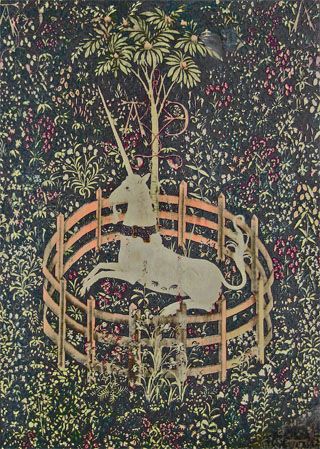 |
South Netherlandish, 1495-1505
Wool warp with wool, silk, sliver, and gilt wefts
12ft. 7/18 in. x 8 ft. 3 in.
The Cloisters, Metropolitan Museum of Art
Gift of John D. Rockefeller Jr., 1937
I had been wanting to see the Unicorn Tapestries at the Cloisters for many years. I have blogged about them here, and even written about their floral designs in this article (posted on my blog) on plants in the decorative arts (the original pdf article is on pp 3-4 of the Summer 2007 issue of the Botanical Artists of Canada Newsletter). As I wrote in my blog post in 2010 (when I first wanted to see them):
I have never been to The Cloisters, but have always known that they house the beautiful tapestries The Hunt of the Unicorn. But, I was lucky to see another set of unicorn tapestries, The Lady and the Unicorn (La Dame à la Licorne), housed in the Musée de Cluny, in Paris.And from my article:
One of the most enchanting mergers of scientific observation and religious symbolism are the tapestries of the Hunt of the Unicorn. These tapestries are covered with the late Medieval tradition of fields of millefleurs. When analyzed carefully, many of these flowers are clearly identifiable, in their correct environment. The Madonna Lily, depicted in The Unicorn in Captivity tapestry, is both a religious symbol of the purity of Mary and also a medicinal plant that treated burns, ulcers and ear infections, amongst other things.Finally, I got to see them during my trip in New York this past August. I tried to take photos (without my flash, as instructed by the guards), but couldn't come up with any decent images, so I had to make do with a postcard of The Unicorn in Captivity from the gift shop.
Here is a link to the Met, which has details of the flowers on the tapestry:
The Unicorn Tapestries: Flowers, Plants and Trees